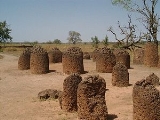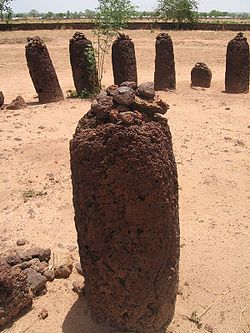
Senegambian stone circles
Encyclopedia

Janjanbureh
Janjanbureh or Jangjangbureh is a town, founded in 1832, on Janjanbureh Island in the Gambia River in eastern Gambia. It was formerly known as Georgetown and was the second largest in the country. It is now the capital of the Central River Division and is best known as home to Gambia's main prison...
and in central Senegal
Senegal
Senegal , officially the Republic of Senegal , is a country in western Africa. It owes its name to the Sénégal River that borders it to the east and north...
. Coordinates: 13° 41 N – 15° 31 W.
Approximate area: 15,000 square miles (39,000 km²). They are sometimes divided into the Wassu (Gambian) and Sine-Saloum
Sine-Saloum
Sine-Saloum is a region in Senegal located north of The Gambia and south of the Petite Côte. It encompasses an area of 24,000 square kilometers, about 12% of Senegal, with a population in the 1990s of 1,060,000....
(Senegalese) circles, but this is purely a national division.
The stones were erected around the eighth century on top of earlier grave
Grave (burial)
A grave is a location where a dead body is buried. Graves are usually located in special areas set aside for the purpose of burial, such as graveyards or cemeteries....
s. The ten to twenty-four stones in each circle vary in size up to ten-ton stones, from 1 to 2.5 metres high and are generally of laterite
Laterite
Laterites are soil types rich in iron and aluminium, formed in hot and wet tropical areas. Nearly all laterites are rusty-red because of iron oxides. They develop by intensive and long-lasting weathering of the underlying parent rock...
. The stones mark burial
Burial
Burial is the act of placing a person or object into the ground. This is accomplished by excavating a pit or trench, placing an object in it, and covering it over.-History:...
s and were erected before the twelfth century. There are around 1,000 stone circle
Stone circle
A stone circle is a monument of standing stones arranged in a circle. Such monuments have been constructed across the world throughout history for many different reasons....
s, the biggest concentration being more than 1,000 stones in fifty-two circles at Djalloumbéré and those around the village of Wassu, which has a museum
Museum
A museum is an institution that cares for a collection of artifacts and other objects of scientific, artistic, cultural, or historical importance and makes them available for public viewing through exhibits that may be permanent or temporary. Most large museums are located in major cities...
devoted to them. One notable circle is actually a V formation. Traditionally, for unknown reasons, people leave small rocks on the stones. The use to which the stones were put is not clear but recent excavation work (2006), reported by the National Geographic Society
National Geographic Society
The National Geographic Society , headquartered in Washington, D.C. in the United States, is one of the largest non-profit scientific and educational institutions in the world. Its interests include geography, archaeology and natural science, the promotion of environmental and historical...
, suggests a funerary purpose given the large number of human remains found at the sites. Archaeologists at the site are pursuing the theory that different parts of a body were buried at different sites and at different times.
On 21 July 2006, the stone circle
Stone circle
A stone circle is a monument of standing stones arranged in a circle. Such monuments have been constructed across the world throughout history for many different reasons....
s were added to the World Heritage List. They are described by UNESCO
UNESCO
The United Nations Educational, Scientific and Cultural Organization is a specialized agency of the United Nations...
as

